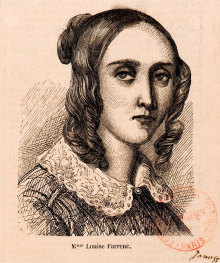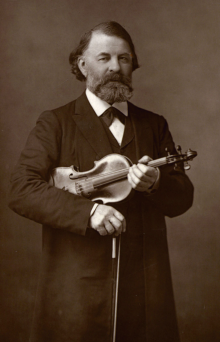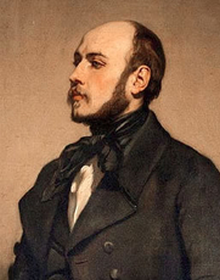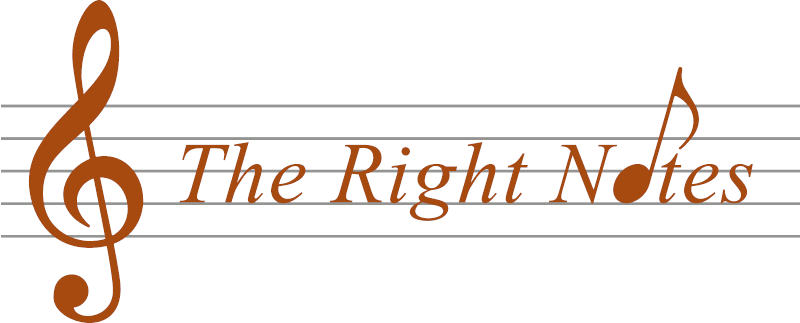Louise Farrenc
I rarely feature an entire symphony in these programmes. OK, once, during a programme on Baroque music, I did play a complete symphony but it lasted all of eight minutes. This time, though, you are going to hear an entire symphony, of more conventional length, without interruption.
What’s more, I am going to tell you very little about it until the end.
What I will tell you is that it’s a wonderful work that I keep going back to. The first movement has a lovely, slow introduction that moves seamlessly into an allegro that seems almost feverish. The slow movement, the second, begins with a beautiful clarinet melody that sticks with me long after the symphony is finished. There’s a scherzo that reminds me of Mendelssohn. And the finale, well, I think it is both bold and tense. Listen out in this symphony for lots of wonderful woodwind.
So, here it is, a symphony in four movements written in, well, I will tell you that and much more later.

That wonderful symphony was written in 1847 by Jeanne-Louise Dumont, better known by her married name, Louise Farrenc. I say better known, but in truth she is hardly known at all. I think, on the basis of the music you just heard, her 3rd Symphony, she should be much, much better appreciated.
So, she wrote this symphony in the mid-19th century when women had virtually no rights and very few professional opportunities. Yet here she is writing what I think was a big and ambitious work.
What’s more, she was a young French woman writing a symphony that you might think sounds much like a German man’s symphony: Schumann, perhaps, or Mendelssohn or even Beethoven?
And she wrote it at a time when symphonic writing wasn’t really all that big in France. In Paris at the time, composers could only prove themselves through opera. She was very much was already bucking the trend by focusing in France on the kind of instrumental music that German composers had made their own in this period.
And bucking the trend at a time in France when it wasn’t easy to stage an orchestral concert did her no favours. A music writer at the time explained Farrenc's lack of universal success: "Unfortunately,” he wrote, “the genre of large-scale instrumental music to which Madame Farrenc, by nature and formation, felt herself called involves performance resources which a composer can acquire for herself or himself only with enormous effort.
“This is the reason why her oeuvre has fallen into oblivion today, when at any other epoch her works would have brought her great esteem.”
By the way, the symphony you heard was premiered at the Paris Conservatoire in a programme that included Beethoven’s 5th.
It could have been overshadowed by the Beethoven but some time after the symphony’s premiere, a critic wrote: “There is no musician who does not remember Mme Farrenc's Symphony performed at the Conservatory, a strong and spirited work in which the brilliance of the melodies contends with the variety of the harmony.”
Recently, Tom Service of The Guardian included Louise Farrenc’s Third Symphony in his list of the 50 Greatest Symphonies of all time.
I cannot track down a YouTube recording of a piano piece by Farrenc called, Valse brilliante, written in the 1860s, but it is available here on Spotify. If you want to listen to a YouTube recording here, check out this Impromptu by Farrenc.
Louise Farrenc was born in Paris in 1804, the year Napoleon was crowned emperor, and died in 1875. Her father, Jacques-Edme Dumont, was a successful court sculptor (he has two pieces in the Louvre), as was her sister Constance and brother Auguste, and she grew up surrounded by artistic types.
In fact, she was brought up in an enclave in the Sorbonne where some 30 artists working for the government lived with their families.
Her family were also painters and were part of a bohemian set in Paris that was very open to allowing women to explore their artistic abilities. Because of this, Louise had the freedom to express her musical passions right from the start. She came to music early and showed great talent for it at a very young age.
She studied piano from the age of six, her first teacher being someone who was taught by Muzio Clementi, and when she was 15 she won a place at the Paris Conservatoire, the only female in her class.
She quickly became an extremely talented pianist, so gifted that some of the leading musical lights of the day wanted to teach her.
After completing her studies, she started her career as a concert pianist, becoming quite famous by the time she was in her 30s. She even embarked on a major concert tour of England when she was 28.
In 1842, at the age of 38, Louise became the only woman to be appointed to the position of professor at the Paris Conservatoire in the 19th century. She stayed there for 30 years and became one of the greatest piano professors in Europe.
As well as a teacher, she gained a reputation as a composer. Star performers such as the violinist Joseph Joachim were keen to perform her music and Berlioz and Schumann both praised her work.
Let’s now hear another Farrenc piece featuring the piano. She wrote a Trio for Clarinet, Cello and Piano in 1861 and this is the adagio, the second movement.
There’s much to admire about Louise Farrenc’s music, but there’s something about the women herself that’s worthy of praise.
Although she was writing all this acclaimed music, Farrenc was paid far less than the male professors at the conservatoire. She was absolutely determined to change this and often protested to the authorities, trying tenaciously to gain equality for nearly a decade.
She also let her music do the talking.
In 1848 she wrote an overture that Berlioz, who was just a year older than Louise, said “was orchestrated with rare talent among women” and had “infectious verse”.

Two years later came the very successful premiere of her four-movement Nonet in E-flat.
The virtuoso violinist Joseph Joachim, who I mentioned earlier, was just 19 and not yet quite world famous when he led on the violin for the premiere of this piece.
The performance was met with what was described as “ecstatic excitement”. Critics and audiences loved her nonet because it seemed to centre on each instrument, highlighting the best of what each one had to offer.
I think this movement, the second, really showcases Farrenc’s skills as a composer.
While Louise Farrenc had some repute during her lifetime as a composer she was notorious in France for her determined stance for equal rights for women – and this, remember, was a long time before the Suffragette movement emerged in the UK.
Her campaign for equal pay was a long one and only succeeded after the success of her nonet. It was such a critical hit that it gave her the courage to complain in writing to the director of the Conservatoire, Daniel Auber, about how much less she was paid than her male colleagues.
Her letter goes into detail, and it is a measure of the respect she had earned that Auber immediately agreed to raise her salary to parity.
However, despite getting the same pay as her male counterparts and despite the fact that she was clearly held in high regard as professor of piano at the conservatoire, she was not allowed to teach composition there – that was most definitely the exclusive reserve of her male colleagues, and remained so until five years before her death.
There’s one aspect of her life I haven’t mentioned. When she was just 17, she married Aristide Farrenc, a flute student 10 years her senior. He performed at some of the concerts regularly given at the artists' colony of the Sorbonne, where Louise's family lived.

After their wedding, she interrupted her studies to give concerts throughout France with her husband.
However, in 1826 Louise took a break from her concert career to give birth to a daughter, Victorine, who also became a composer concert pianist. Victorine was a rising star at the Paris Conservatoire, winning its premier prize, but she died after a long illness – she had TB – when she was just 33, 16 years before her mother.
Louise was grief-stricken and she never wrote a note after her daughter’s death. However, she did become an avid advocate of her daughter’s compositions, editing and performing it. Instead, she worked as an academic and student of music. With Louise’s help, her husband opened a publishing house in Paris which was to become one of France’s leading music publishers.
Her husband, who knew he was something of a hack as a performer, was a great proponent of his wife's work and he supported her entirely. It is mainly due to him that Louise Farrenc's compositions are still available to audiences today, for he published many of her works. Today there are 49 known Farrenc works with opus numbers.
I read a good quote about the couple’s working relationship: "Aristide Farrenc was able to sense his young wife’s talent for composing, to encourage her, virtually force her, they say, to make available to the public works which her modesty, of a degree rarely encountered, impelled her to keep unpublished."
This sense of reserve as far as her work is concerned is confirmed in something else I read about her. Someone wrote: “Modest, even timid, fleeing fame as diligently as other artists seek it, Madame Farrenc would have consigned her musical production to an external silence.”
She went on to collaborate with her husband in researching and writing a 23-volume anthology of keyboard music from Bach to Beethoven. The first edition of her Les Tresor de Pianistes was published in 1861. Louise continued to work on updating the anthology after her husband died suddenly in 1865 at the age of 60, and saw the final edition published eight in 1872, and on New Year’s Day the following year she retired as Professor of Piano at the conservatoire. She died, aged 69, three years later.
Let’s hear some more keyboard music, now, and two etudes. These were written in 1839 as part of a set of 30 studies. These etudes are interesting because the show that Louise Farrenc brought a real intellectual rigour to her composing. They became something of standard at the Paris Conservatoire not least because they begin in the style of Bach and then move forward in time.
Here’s what Robert Schumann wrote about an earlier set of etudes by Louise: “These are small, neat, sharp studies, so judicious in their outline, so finished, that one must become fond of them – all the more so because a very gentle romantic fragrance wafts over them.”
Loiuse Farrenc wrote three symphonies. You heard part of the 3rd earlier. Now, I would like you to hear part of her 2nd Symphony, which she wrote in 1842.
The Romantic era in music was in full flow at this time, and I’ve read suggestions that perhaps Farrenc didn’t become a star composer was that, musically, she was a bit conservative. What do you think?
This is the second movement of her 2nd Symphony, written in 1845, two years before she wrote the 3rd, which you heard at the beginning of the programme.
I mentioned earlier that the violinist Joseph Joachim was a big champion of her work. Here is an example of her writing for violin, a piece written in 1850. This is the third movement of her Violin Sonata No. 2.
Three years after Farrenc died in 1875, a French critic wrote this…
"Unfortunately, the genre of large-scale instrumental music to which Madame Farrenc, by nature and formation, felt herself called involves performance resources which a composer can acquire for herself or himself only with enormous effort.
“Another factor here is the public, as a rule not a very knowledgeable one, whose only standard for measuring the quality of a work is the name of its author.
“If the composer is unknown, the audience remains unreceptive, and the publishers, especially in France, close their ears anyway when someone offers them a halfway decent work. Such were the obstacles that Madame Farrenc met along the way and which caused her to despair. This is the reason why her work has fallen into oblivion today, when at any other epoch her works would have brought her great esteem."
Before we close, let’s hear one of Farrenc’s earlier pieces, the finale of her Concerted Variations on a Swiss Air. I am sure you will enjoy it.
Featured composers:
Featured genres:
Louise Farrenc playlist
Each Spotify track has been chosen specifically; however, the corresponding YouTube videos may be performed by different orchestras.
